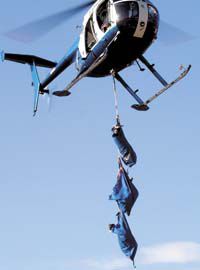| Bighorn sheep take a first class flight to their new home in John’s Canyon. |
Some local bighorn sheep got the ride of a lifetime recently as the Division of Wildlife resources captured and transplanted more than 30 of the majestic creatures.
According to DWR press release, over the past few weeks department officials have been working to safely and humanely move the sheep from Southeastern Utah to John’s Canyon near a tributary of the San Juan River. The San Juan River empties into the Glen Canyon National Recreation Area and Lake Powell.
Bighorn sheep are a major attraction in Castle Valley as they can be found near the base of the Bookcliff’s in Sunnyside in the summer and within the San Rafael Swell.
DWR Wildlife Manager Bill Bates explained that wild sheep had been extirpated from John’s Canyon and the agency’s intention was to restore the herd of wild sheep to its former range.
“Surplus animals were collected from healthy herds in the vicinity of Green River and Moab and then trucked south,” said Bates via the press release.
The DWR reports that bighorns inhabit steep rocky terrain, which is best accessed by helicopter. The DWR contracted Pathfinder Helicopter Services for the capture project.
Sheep were located by flying over terrain, where good sized populations were known to occur. Once sheep were located, biologists deployed a net from the ship entangling the animals.
“Captured sheep were secured in a nylon sleeve and flown to a staging area for a health inspection and transfer to a horse trailer,” explained Bates.
After collecting a trailer full of sheep, the woolies were trucked to their new home near the Utah-Arizona border. The new herd now consists of five rams, 22 ewes and three lambs.
“They occupy habitat similar to that from which they came,” said Bates. “John’s Canyon features craggy cliffs and a permanent water source. With some luck the herd should grow to its former size and geographic distribution.
According to National Geographic, bighorn males are famous for their large curled horns.
“These impressive growths are a symbol of status and a weapon used in epic battles across the Rocky Mountains,” quoted the site. “Fighting for dominance or mating rights, males face each other, rear up on their hind legs and hurl themselves at each other in charges of some 20 miles per hour. The resounding crash can be heard echoing through the mountains as the confrontation is repeated, sometimes for many hours until one ram submits and walks away. The animals thick bony skull usually prevents serious injury.”
A Rocky Mountain bighorn ram’s horns can weigh 30 pounds – more than all the bones in the rest of his body combined. Females also have horns but they are smaller in size. The sheep inhabit the mountains from Canada to Mexico.
The wild herds live in social groups but rams and ewes typically meet only to mate. In the winter bighorn herds move to lower elevation mountain pastures and according to DWR official Brett Stettler the herds commonly seen near the base of Whitmore Canyon typically move back and forth between the base of that canyon and the Green River area.
The lambs which the DWR hopes will repopulate the John’s Canyon area are born each spring on high secluded ledges protected from bighorn predators, according to the National Geographic website. Bighorn predators include wolves, coyotes and mountain lions. While the ledges protect against most predators they do not aid in hiding the small lambs from golden eagles.
The young can walk soon after birth and at one week old each lamb and its mother join the others in the herd.
“Lambs are playful and independent,” concluded the site, “though their mothers nurse them occasionally for up to six months.”

